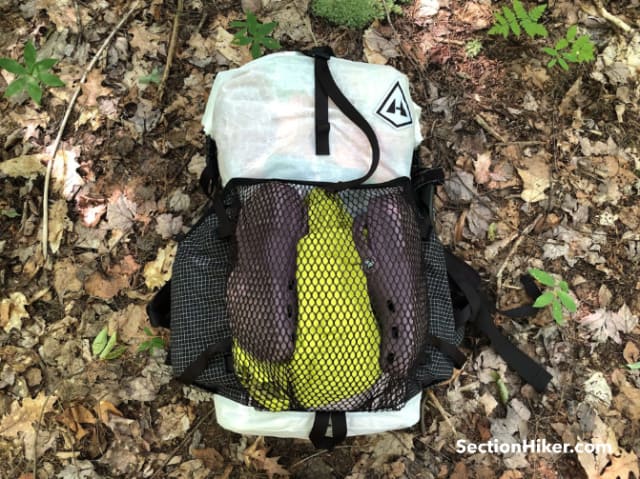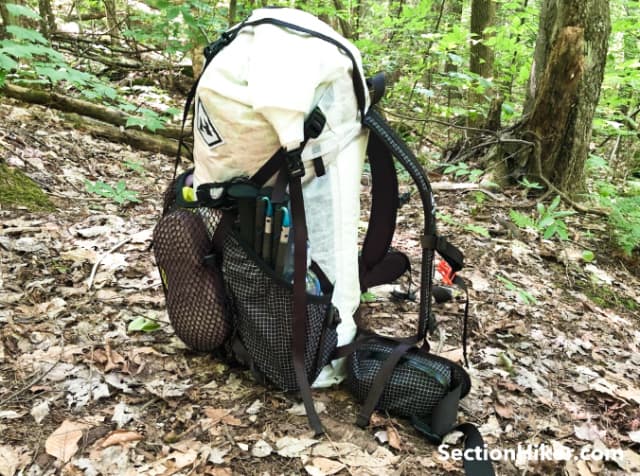The Hyperlite Mountain Gear Junction 55 is a Dyneema DCF backpack designed for multi-day backpacking trips and thru-hikes. Weighing 32 oz, it has a total capacity of 65L, including 55L of main compartment storage and 10L of space distributed between its front mesh and side bottle pockets. The Junction 55 is identical to Hyperlite’s Southwest 55 and Windrider 55 backpacks with the exception of its external pockets. These are all solid fabric on the Southwest backpack for durability when hiking off-trail, and all mesh on the Windrider for drying damp gear. The Junction is a compromise between these two, with solid side pockets, and a mesh front pocket so you can make sure you have all your gear when you pack up and to dry out damp items.
Hyperlite Mountain Gear Junction 55 Backpack
Comfort
Weight
Suspension
Features
Adjustability
Sizing
Durability
Specs at a Glance
- Weight: 32 oz average (the size small weighs 30.5 oz)
- Gender: Unisex
- Type: Roll-top
- Frame: Two aluminum frame stays
- Hydration system compatible: Yes
- Bear canister compatible: Vertical
- Internal Volume: 3400 cubic in. (55L)
- External Volume: 600 cubic in. (9.8L)
- Center Pocket: 300 cubic in.
- Side Pockets: 150 cubic in.
- Material:
- Body: Dyneema Composite Hybrid 50D
Bottom: Dyneema Composite Hybrid 150D
External Center Pocket: Mesh
External Side Pockets: Hardline with Dyneema
- Body: Dyneema Composite Hybrid 50D
- Torso lengths: Small (15-17″), Medium (17-19″), Large (19-21″), Tall (21″+)
- Max Recommended Load: 35-40 lbs
Backpack Organization and Storage
The Hyperlite Mountain Gear Junction 55 is a roll-top ultralight backpack with a large main compartment, an internal hydration system sleeve, side water bottle pockets, a mesh front pocket, and large hip belt pockets. The advantage of a roll-top pack is that you can roll down the pack’s extension collar to create top-down compression or reduce its volume when it’s not needed.
For instance, you can turn the Junction 55 into a Junction 40 backpack simply by rolling down the top of the main compartment. That’s the only difference between the two packs and something to consider if you can’t decide between the 40L or 55L packs. The Junction is available in the white 50D DCF that Hyperlite uses to make their pack bodies as well as the more durable 150D DCF black color. I actually prefer the white color, because it makes it much easier to see the contents in the main compartment.

When using a roll-top backpack, most people store the gear they use at night on the inside of the pack and the gear they need during the day, including rain gear, on the outside, to ensure that all the important stuff stays dry and clean. Damp items like water bottles, a water filter, damp tents, rain gear, snacks, a sweater, hat, etc. are stored in the external pockets where they’re easily accessible without having to unpack the main pack.

The side pockets of the Junction are solid for added durability off-trail and on narrow trails where bushes can catch on mesh pockets and rip them, while the front mesh pocket makes it easy to check whether you have all your gear when you stop and facilitates drying. Tall and deep, the side pockets can hold two 1L water bottles each. They are roomy enough for me to place my tent in if I so choose, although I prefer to keep my tent on the inside of my pack. My preferred use for side pockets is for water bottles and my water filtration.
The front mesh pocket is super large and pleated with a stretchy top rim. It holds both my Crocs and my rain gear easily… my preferred packing style. Being made of mesh, one could store all sorts of soggy gear, or stuff a fleece, mittens, and hat inside and still see what’s in the pocket.

The inside of the main compartment has a mesh hydration sleeve to hold a hydration bladder and a side port for running a hose. It also makes a good place to store a map, car keys, a compass, or other small items that you want to keep safe. While I enjoy hydration bladders for day hikes, I rarely use them for backpacks as a full compressed backpack makes filling a hydration bladder a bit of a nuisance. On backpacks or longer day hikes, I prefer using water bottles.
The hip belt pockets on the Junction are generously sized for storing small items like a smartphone. I can even store my largish iPhone in them, which is often a challenge to fit in other hip belt pockets. I can also fit 5 snack bars into each pocket, so you should be able to fit any configuration of personal items, food, snacks, camera, phone, compass, or the like into them.

Backpack Compression and External Attachments
The Junction has two tiers of side compression straps that can be used to shrink and stabilize your load or to strap awkwardly sized objects to the pack like a foam sleeping pad or snowshoes. There’s also a Y-strap that runs over the top of the main compartment which can be used for compression or to carry additional gear like a rope coil, a jacket, or even an extra food bag. The only good place to store a bear canister however is inside the main compartment.

Backpack Frame and Suspension
The Junction 55 has two aluminum frame stays instead of a full-frame because it’s intended to carry lighter loads. These are held in two long pockets on the inside of the main compartment and help channel the load to the pack’s hip belt. The frame stays are pre-bent when you get the pack but can be removed and adjusted, if required, to fit your body shape. The pack does not have external load lifters, something that HMG doesn’t feel is necessary because their packs fit so close to your hips and are available in a large number of sizes to better match your torso length. (see our interview with Hyperlite Mountains Gear’s chief designer for more info.)

The Junction (and all HMG backpacks) has a sewn-on hip belt, unlike many other ultralight backpacks where the hip belt is removable and anchored using velcro. This positions the hip belt closer to your hip bones and provides a better, more responsive carry since the hip belt is an integral part of the main pack and not an add-on.
The sewn-in shoulder straps are of a simple curved design, with 3/8” foam, with external daisy chains for attaching extra pockets and gear. Some brands make female-specific packs with more pronounced S-shaped curved shoulder straps so women will want to try this pack to ensure that the straps will feel comfortable with their body shape. I personally feel super comfortable in this pack and did not object at all to the unisex-shaped shoulder straps. The sternum strap is adjustable, which is important as I prefer to place mine a bit lower on my shoulder straps, with a self-tensioning elastic and an integrated whistle.
The sewn-in hipbelt is also constructed with 1/4” closed cell foam. The hip belt, too, is unisex in design. I found that the 3” wide foam conformed to my hips just fine. Comfortable but not bulky.

Recommendation
The Hyperlite Mountain Gear Junction 55 offers a similar configuration to HMG’s other backpack models, in that it is a roll-top pack with three external pockets. But the configuration of the solid side pockets in combination with a mesh front pouch makes this particular pack an outstanding choice! I’m thrilled with this new addition to the Hyperlite Mountain Gear line of packs. While I already own a Hyperlite Southwest 40 backpack which I use for day hikes and off-trail bushwhacks, I feel that the Junction 55, with its new front mesh pocket, is tough enough to hold up to rough use and all manner of hiking, backpacking, rock scrambling and bushwhacking.
Disclosure: Hyperlite Mountain Gear donated a backpack for review.
SectionHiker is reader-supported. We only make money if you purchase a product through our affiliate links. Help us continue to test and write unsponsored and independent gear reviews, beginner FAQs, and free hiking guides. SectionHiker.com Backpacking Gear Reviews and FAQs
SectionHiker.com Backpacking Gear Reviews and FAQs 
Thanks for this review! Would you consider the Junction or the Southwest the better choice for the Southern Appalachians, especially the Smokies? Which would you prefer for Philmont or a substantially similar southwestern location? Would you have any concerns with the mesh holding up in either location? Thanks again!
They label the “sweet spots” for their packs as follows:
Windrider – Appalachian Trail
Southwest – Continental Divide Trail
Junction – Pacific Crest Trail
My instinct is that with the humidity of the lower AT and the Smokies, you would benefit with the mesh pouch of the junction over the abrasive durability of the Southwest.
That’s just marketing…and bad marketing at that..because it requires the customer to know what the conditions on those trails are. Most don’t.
Most of their customers aren’t thru-hikers, and thru-hikers don’t know them before their thru-hike either.
I love my HMG 3400 Junction Tall in black. I am 6’3” 285 and have been backpacking for 45 years and still have my original external frame pack. Back packs have evolved just like communications, at light speed. I got the 3400 to use during thru hikes where I might experience three seasons and need to add winter gear and shed winter gear and switch to warm weather gear and for those areas with long walks to resupply points. For the short hikes I’ve taken so far I have been extremely impressed with how comfortable it’s been in warm Florida weather. Looking forward to doing a 137 mile section of the Florida trail during the Christmas break. Keep those blazes in front of you!
Thanks for the great review… My day pack has a suspended mesh panel that keeps it off my back. I find it makes for a less sweaty hike. Do you find this pack hot, especially during the Summer?
Not particularly. I sweat when I carry any kind of backpack, ventilated or not, in summer.